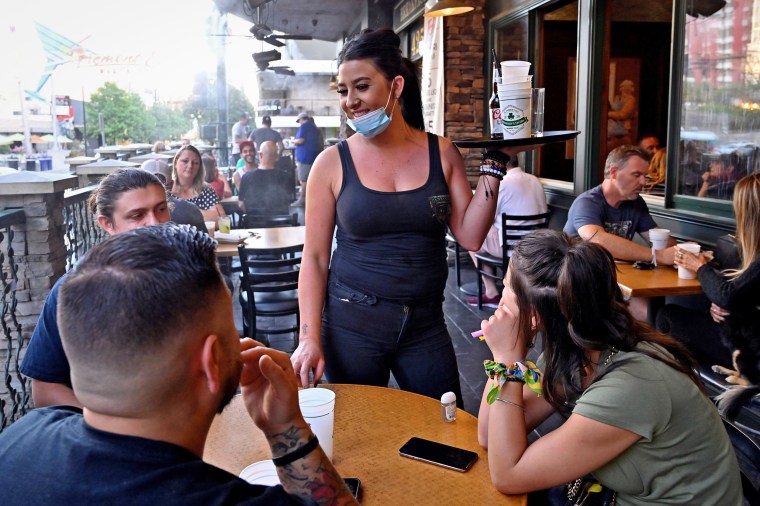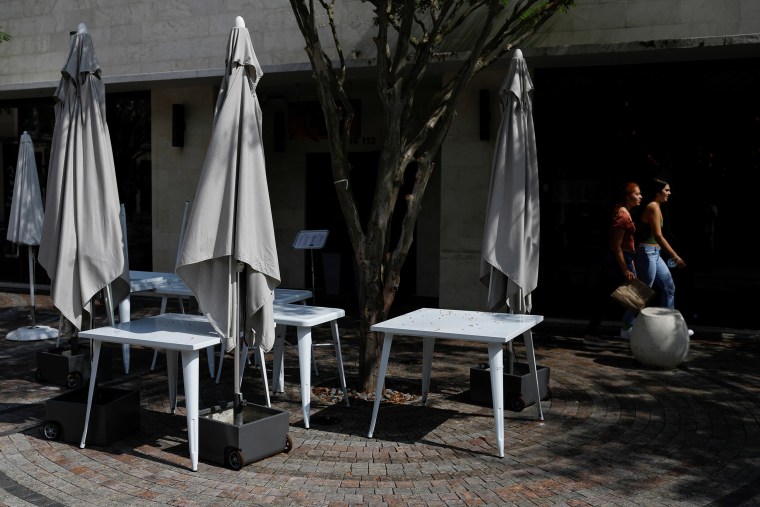LONDON — Remember how dining out used to be — the dim light, the flickering candle, the cozy corner, the romance?
Well, as the poet Robert Graves wrote following a previous cataclysm — World War I — "Goodbye to all that."
And so it is that, post-coronavirus, dining out, that quintessentially intimate experience, just isn't going to be the same again. As restaurateurs seek to attract customers, the use of enticing words such as "intimate," "cozy" and maybe even "atmospheric" may fall by the wayside.
They'll likely be replaced by words such as "bright," "clean," "spacious" and — who knows? — maybe even "sterile." Not the most romantic of words, but there are lives at stake.
At least one restaurant is planning to host diners under individual greenhouses. Others will put hand sanitizer on each table, along with individually wrapped silverware.
Diners have always been concerned about safety but now they will want clear indications that the space is germ-free, said Alex Susskind, a professor and associate dean at the Cornell University School of Hotel Administration.

There were regulations that, in the past, restaurateurs followed discreetly. Now, diners will want the cleanliness protocols, like surface cleaning and an emphasis on a contactless experience, to be entirely visible.
“If they can’t verify it with their own eyes, they’ll be a little hesitant,” Susskind said. “They want to see the masks, they want to see the gloves, they want to see all that stuff in the past would’ve been invisible.”
And so it is that restaurateur Francesca Chaney is totally re-imagining her Brooklyn café as she contemplates the post-pandemic era.
Chaney has had to transform her business model to ensure that Sol Sips, her vegan restaurant, continues to attract customers.
For one thing, the restaurant only seats eight people — and rather snugly at that.
“It gives me a little bit of anxiety just thinking about having so many people in here at once,” she said. Which, actually, is something she does not plan to allow in the forseeable future.
Instead, she plans to install a takeout window and run a curbside pickup and delivery operation for at least a year.
“The only saving grace for the business is restaurateurs are incredibly savvy and really good at adjusting,” Susskind said. “They have a fight in them.”
They are going to need it.
Nine out of 10 restaurateurs who are thinking about reopening listed health and safety as their No. 1 concern, according to a new James Beard Foundation survey. Surveyed restaurateurs listed personal protective equipment as one of their top five expenses and some cited a need to spend up to $50,000 beyond what they are currently spending in order to reopen.
After much anticipation, the Centers for Disease Control and Prevention published guidelines Thursday for how restaurants can safely reopen, including socially distant tables and masks. The states that have begun to ease their lockdown restrictions are pulling back the curtain on what the future of dining out might look like.
One Houston restaurateur now offers outdoor seating only. Coltivare has bottles of hand sanitizer and silverware vacuum-sealed in plastic at each table. Diners wait in their cars until their tables are ready. Waiters clad in masks and gloves take orders for drinks, appetizers and main courses all at once.
McDonald’s released its COVID-19 safety standards last week. The guidelines include reducing the number of tables, increasing the cleaning of surfaces and requiring staff to wear masks and gloves.
Cincinnati is one of a handful of cities that will shut down traffic on some roads so restaurants can expand their outdoor dining spaces and can keep tables spread apart.
Some owners are introducing out-of-the box solutions to adhere to emerging advice. The Inn at Little Washington, a Michelin three-star restaurant in Virginia, plans to seat dressed up mannequins at empty tables when it reopens May 29. In the Netherlands, restaurant owner Willem Velthoven, who runs Mediamatic ETEN, is hosting diners in individual glass greenhouses. Waiters serve food on a plank that fits through a sliding door on the greenhouse.
"It has a really nice intimacy to sit in a confined space that's transparent," Velthoven said. "You feel safe and at the same time you have a good overview of your surroundings."

Susskind said consumers crave human connection when they dine out and the more extreme solutions are disruptive. He said extravagant answers can be expensive and may not be viable for many restaurants.
“If we get to the point where you have to be in glass bubbles, I think we're in a way worse situation than we are now,” he said.
While he thinks people will eventually patronize restaurants again, Susskind said the transition to safe and comfortable in-house dining will be slow. He said takeout and delivery will become a larger part of the dining-out experience. Eateries need to consistently deliver high quality takeout orders by updating their menus with dishes that travel well.
While planning her takeout window installation at Sol Sips, Chaney is selling prepared meal kits that customers just need to heat up. Chaney’s prepackaged food will be sold in grocery stores too, which she said she hopes brings her meals to those who cannot or do not want to return to restaurants.
“There isn’t a way to recreate dining out,” she said. “There’s been so much love packed into this space and there’s nothing like it.”